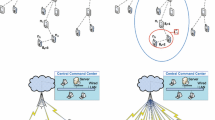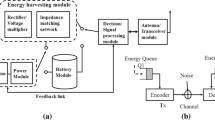Abstract
Energy efficiency is widely recognized as an important factor for future cellular networks. For mobile devices, energy efficiency leads to extended battery life. Existing works consider battery to be equally important for all users at all time. We recognize that the value of a device’s battery depends on the user’s target usage. In particular, we introduce the notions of valueless and valued battery, as being the available battery when the user does or does not have access to a power source, respectively. We argue that user experience only depends on valued battery. We propose a cooperative system to help raise the overall amount of valued battery in the network. Our system makes use of device-to-device communications underlaying LTE to create cooperative relay links between users. Users who expect to have a large amount of valueless battery help relay traffic for users with a small amount of valued battery. We develop our system as a proximity service for future LTE releases. We propose a framework to study utility functions to evaluate the value of battery. We show that with appropriate utility functions, a set of thresholding cooperative rules ensure network performance improvement. We illustrate this improvement through simulation. Our simulator source code is made available to the public.








Similar content being viewed by others
References
Arthur, C. (2011). How the smartphone is killing the PC. http://www.guardian.co.uk/technology/2011/jun/05/smartphones-killing-pc. Accessed 15 Sept 2014.
Cisco. (2014). Global mobile data traffic forecast update, 2013–2018. http://www.cisco.com/c/en/us/sol-utions/collateral/service-provider/visual-networking-index-vni/white_paper_c11-520862.html. Accessed 15 Sept 2014.
Carroll, A., & Heiser, G. (2010) An analysis of power consumption in a smartphone. In Proceedings of the 2010 USENIX conference on USENIX annual technical conference,USENIXATC’10 (p. 21). Berkeley, CA: USENIX Association.
Huang, J., Qian, F., Gerber, A., Mao, Z. M., Sen, S., & Spatscheck, O. (2012). A close examination of performance and power characteristics of 4G LTE networks. In Proceedings of the 10th international conference on Mobile systems, applications, and services, MobiSys ’12 (pp. 225–238). New York: ACM.
Badic, B., O’Farrrell, T., Loskot, P., & He, J. (2009). Energy efficient radio access architectures for green radio: Large versus small cell size deployment. In IEEE 70th Vehicular Technology Conference Fall (VTC 2009-Fall) (pp. 1–5).
Zhang, J., Ge, X., Chen, M., Jo, M., Yang, X., Du, Q., et al. (2013). Uplink energy efficiency analysis for two-tier cellular access networks using kernel function. Telecommunication Systems, 52(2), 1305–1312.
Chiasserini, C.-F., & Magli, E. (2004). Energy-efficient coding and error control for wireless video-surveillance networks. Telecommunication Systems, 26(2–4), 369–387.
Zhang, Y., Huang, L., Xu, H., & Yang, Z. (2013). An incentive energy-efficient routing for data gathering in wireless cooperative networks. Telecommunication Systems, 52(4), 1977–1987.
Meshkati, F., Poor, H., Schwartz, S., & Balan, R. (2009). Energy-efficient resource allocation in wireless networks with quality-of-service constraints. IEEE Transactions on Communications, 57(11), 3406–3414.
Ba, P., Niang, I., & Gueye, B. (2014). An optimized and power savings protocol for mobility energy-aware in wireless sensor networks. Telecommunication Systems, 55(2), 271–280.
Miao, G., Himayat, N., & Li, G. (2010). Energy-efficient link adaptation in frequency-selective channels. IEEE Transactions on Communications, 58(2), 545–554.
Hussain, S., Azim, A., & Park, J. (2009). Energy efficient virtual mimo communication for wireless sensor networks. Telecommunication Systems, 42(1–2), 139–149.
Garnica, J., Chinga, R., & Lin, J. (2013). Wireless power transmission: From far field to near field. Proceedings of the IEEE, 101(6), 1321–1331.
Ta, T., Baras, J. S., & Zhu, C. (2014). Improving Smartphone Battery Life Utilizing Device-to-device Cooperative Relays Underlaying LTE Networks. In IEEE International Conference on Communications.
Chon, Y., Ryu, W., & Cha, H. (2013). Predicting smartphone battery usage using cell tower id monitoring. Pervasive and Mobile Computing. http://www.sciencedirect.com/science/article/pii/S1574119213000801. Accessed 15 Sept 2014.
Kyosti, P., Meinila, J., Jamsa, T., Zhao, X., Hentila, L., Yli-talo, J., & Alatossava, M. (2007). WINNER II Channel Models. https://www.ist-winner.org/WINNER2-Deliverables/D1.1.2v1.1.pdf. Accessed 15 Sept 2014.
3GPP. (1998). Selection procedures for the choice of radio transmission technologies of the UMTS, 3GPP Std. TR 30.03U.
Ta, T. (2014). Battery deposit service simulator. https://github.com/tuan-ta/bds. Accessed 15 Sept 2014.
Antonopoulos, A., Kartsakli, E., & Verikoukis, C. (2014). Game theoretic D2D content dissemination in 4G cellular networks. IEEE Communications Magazine, 52(6), 125–132.
Antonopoulos, A., & Verikoukis, C. (2014). Multi-player game theoretic mac strategies for energy efficient data dissemination. IEEE Transactions on Wireless Communications, 13(2), 592–603.
Janis, P., Yu, C.-H., Doppler, K., Ribeiro, C., Wijting, C., & Hugl, K. (2009). Device-to-device communication underlaying cellular communications systems. International Journal of Communications, Network and System Sciences, 2(3), 169–178.
Yu, C.-H., Doppler, K., Ribeiro, C., & Tirkkonen, O. (2011). Resource sharing optimization for device-to-device communication underlaying cellular networks. IEEE Transactions on Wireless Communications, 10(8), 2752–2763.
Elkotby, H., Elsayed, K., & Ismail, M. (2012). Exploiting interference alignment for sum rate enhancement in D2D-enabled cellular networks. In Proceedings of IEEE WCNC 2012.
Kone, V., Yang, L., Yang, X., Zhao, B.Y., Zheng, H. (2010). On the feasibility of effective opportunistic spectrum access. In Proceedings of the 10th annual conference on Internet measurement, IMC ’10 (pp. 151–164). NewYork, NY: ACM
3GPP. (2013). Technical Specification Group Services and System Aspects; Feasibility study for Proximity Services (ProSe) (version 12.1.0), 3GPP Std. TR 22.803.
Raghothaman, B., Deng, E., Pragada, R., Sternberg, G., Deng, T., & Vanganuru, K. (2013). Architecture and protocols for LTE-based device to device communication. In International Conference on Computing, Networking and Communications (ICNC) (pp. 895–899).
Yang, M. J., Lim, S. Y., Park, H. J., & Park, N. H. (2013). Solving the data overload: Device-to-device bearer control architecture for cellular data offloading. IEEE Vehicular Technology Magazine, 8(1), 31–39.
Kansal, A., Hsu, J., Zahedi, S., & Srivastava, M. B. (2007). Power management in energy harvesting sensor networks. ACM Transactions on Embedded Computing Systems, 6(4), 32.
Buttyan, L., & Hubaux, J.-P. (2001). Nuglets: A virtual currency to stimulate cooperation in self-organized mobile ad hoc networks. Technical Report.
Anderegg, L., & Eidenbenz, S. (2003). Ad hoc-vcg: a truthful and cost-efficient routing protocol for mobile ad hoc networks with selfish agents. In Proceedings of the 9th annual international conference on Mobile computing and networking, MobiCom ’03 (pp. 245–259). NewYork, NY: ACM
Chen, B. B., & Chan, M. C. (2010). Mobicent: a credit-based incentive system for disruption tolerant network. In INFOCOM, Proceedings IEEE, March 2010 (pp. 1–9).
Duan, L., Kubo, T., Sugiyama, K., Huang, J., Hasegawa, T., & Walrand, J. (2012). Incentive mechanisms for smartphone collaboration in data acquisition and distributed computing. In INFOCOM, Proceedings IEEE, March 2012 (pp. 1701–1709).
Nakamoto, S. (2009). Bitcoin: A peer-to-peer electronic cash system. http://bitcoin.org/bitcoin.pdf. Accessed 15 Sept 2014.
Wei, K., Smith, A., Chen, Y.-F., & Vo, B. (2006). Whopay: A scalable and anonymous payment system for peer-to-peer environments. In 26th IEEE International Conference on Distributed Computing Systems. ICDCS 2006 (p. 13).
Baker, M. (2011). Chapter 18. Uplink Transmission Procedures (pp. 449–462). New York: Wiley.
3GPP. (2011). Evolved Universal Terrestrial Radio Access (E-UTRA); Physical layer procedures (version 10.4.0), 3GPP Std. TS 36.213.
Nokia Corporation (2012). Further results on network signalling load and UE power consumption (R2–120367). Nokia Corporation.
Renesas Mobile Europe Ltd. (2012) Impact of DRX to always-on background traffic (R2–120578). Renesas Mobile Europe Ltd.
NIST. (2014). Incomplete beta functions. http://dlmf.nist.gov/8.17. Accessed 15 Sept 2014.
Bremaud, P. (1999). Markov chains, Gibbs fields, Monte Carlo simulations, and queues. Berlin: Springer.
Xu, J., & van der Schaar, M. (2013). Token system design for autonomic wireless relay networks. IEEE Transactions on Communications, 61(7), 2924–2935.
Nisan, N., Roughgarden, T., Tardos, E., & Vazirani, V. V. (2007). Algorithmic Game Theory. New York: Cambridge University Press.
3GPP. (2012). LTE Radio Access Network (RAN) enhancements for diverse data applications, 3GPP Std. TR 36.822.
Acknowledgments
This material is based upon research partially supported by the National Science Foundation (NSF) grants CNS1018346 and CNS1035655.
Author information
Authors and Affiliations
Corresponding author
Appendices
Appendices
Proof of Lemma 1
Since the consumption process \(\zeta _L(\cdot )\) is non-negative, and the utility function is monotonically non-decreasing in \(B\), the helper will never gain utility after a cooperative session
From (4)
(5) follows from property (1) of the utility function. \(\square \)
Expected valued usage time for Gaussian consumption process
We want to calculate the expected valued usage time \(\mathbb E[T_V]\) for the case the consumption process \(\zeta _L(t)\) is Gaussian. As seen in (20), the time until outage \(T_O\) is approximated as a Gaussian random variable \(\mathcal N(\mu ,\sigma ^2)\). From (10)
Since \(T_O \ge 0\), for the approximation \(T_O \sim \mathcal N(\mu ,\sigma )\) to hold we need \(\varPhi (\frac{-\mu }{\sigma }) \approx 0\). This is true for sufficiently large \(\mu \). Consequently, we have
To compute the last term of (59), we make the change of variable \(u = \frac{(\tau -\mu )^2}{2\sigma ^2}\). We have \((\tau -\mu )d\tau = \sigma ^2 du\). Therefore,
Finally (59) becomes
Rights and permissions
About this article
Cite this article
Ta, T., Baras, J.S. Exploiting diversity of usage to enhance user equipment energy efficiency in LTE networks. Telecommun Syst 59, 5–23 (2015). https://doi.org/10.1007/s11235-014-9883-6
Published:
Issue Date:
DOI: https://doi.org/10.1007/s11235-014-9883-6




